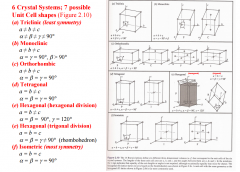![]()
![]()
![]()
Use LEFT and RIGHT arrow keys to navigate between flashcards;
Use UP and DOWN arrow keys to flip the card;
H to show hint;
A reads text to speech;
22 Cards in this Set
- Front
- Back
|
What is a mineral? |
A mineral is a naturally occurring solid with a long-rangecrystalline structure and a definite, but not necessarily fixed,chemical composition. |
|
|
Why petroleum and oil are not considered minerals? |
• Petroleum and coal are not minerals because they do not have a definitechemical formula or an ordered atomic arrangement |
|
|
What is a mineraloid? |
• Mineraloids are mineral-like materials that lack a longrangecrystalline structure.• Examples: amorphous solids such as volcanic glass (left photobelow, obsidian) and microcrystalline quartz (right photobelow; this variety is opal). |
|
|
What is a metamict? |
The termmetamict is used to describe minerals that have disruptedstructures due to radioactive decay - metamict mineralsare formally classified as mineraloids. |
|
|
What are the two types of symmetry in crystallography? |
• In crystallography, we deal with two types of symmetry: - Translational symmetry - repetition of a motif througha volume of space - Point symmetry - repetition of a motif around a pointor a collection of points (such as a line) |
|
|
What is a,b and c in crystallography? |
• The dimensions (lengths) of thetranslations in the a, b and c directionsfor the minerals are also called a, band c; these dimensions are given inthe textbook (for example see themineral olivine, p. 338). |
|
|
What is alfa, beta and gama? |
• The symbols alfa, beta and gama are used todescribe the angles between thecrystallographic axes: is the angle between b & c is the angle between a & c is the angle between a & b |
|
|
What are the bravais lettices? |
• The five possible plane latticesmay be translated into the thirddimension producing 14 possiblespace lattices known as theBravais lattices (Figure 2.10). |
|
|
What are the crystal systems? How many? How many unit cells are possible? |
• The 14 possible Bravais latticescan be sorted by their unit cellshape into 6 crystal systems (Fig.2.10). For the hexagonal system,note there are 2 unit cell shapes,so there are a total of 7 possible“unit cell” shapes. |
|
|
WHat are the names of the crystal systems and the relationship among the axis. |

|
|
|
Is there only one shape for each crystal system? |
• For each crystal system, various crystal shapes are possible,but their internal structure always matches the unit cell of thatsystem. |
|
|
What is point symmetry? |
• Point symmetry deals with how a motif is repeated around a point or acollection of points (i.e. a line). |
|
|
What are the operations in the point symmetry? |
• There are three simple point symmetry operations: reflection rotation inversion |
|
|
What is the inversion in the point symmetry? |
Inversion• Inversion symmetry exists ifan imaginary line can be drawnfrom a crystal feature throughthe middle of a crystal(inversion center) thatintersects an identical featureequidistant on the op |
|
|
What is space groups? |
• Space groups represent the combination of point symmetryand translational symmetry. |
|
|
What are the other symmetry operations? |
1. Glides: produced by acombination of a translationand a reflection |
|
|
What does the Steno's Law say? |
the angle between equivalentfaces on crystals of the same mineral is always the same. |
|
|
What is the Law of Bravais? |
Common crystal faces are parallel to latticeplanes that have a high lattice node density. |
|
|
what is Law of Haűy? |
Crystal faces make simple rational interceptson crystal axes. • What does that mean? Faces intersect the crystal axes atdistances from the axes origin that are in simple ratios.• So an individual crystal face can be uniquely identified byspecifying the set of rational intersection points at which that faceintersects the crystallographic axes.• Mineralogists use a system called Miller Indices for this. |
|
|
What are miller indices? |
• Miller Indices: a shorthand system to describe theorientation of crystal faces.• Miller indices are written (h,k,l); using parentheses. |
|
|
WHat is a crystal zone? |
• A crystal zone is a collection ofcrystal faces that are all parallelto a common line - the zone axis.• A zone is noted using [squarebrackets] around the zone axis. |
|
|
What is a crystal form? |
• A crystal form is a collection of equivalent crystal faces related toeach other by the symmetry of the mineral. • Crystal forms are indicated by curly brackets {} around theMiller indices of the one of the faces that comprise the form. |

